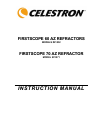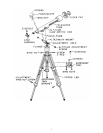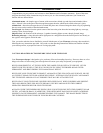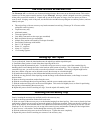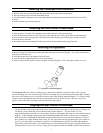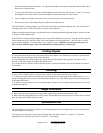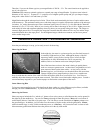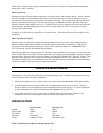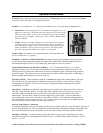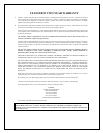
8
The drawing of Jupiter provides a good representation of what you can expect to see with moderate magnification,
during good “seeing” conditions.
Observing the Sun
Although overlooked by many amateur astronomers, solar observation is both rewarding and fun. However, because
the sun is so bright, special precautions must be taken when observing this star, so as not to damage your eyes or
your telescope. Never project an image of the sun through the telescope. This can damage the telescope and/or any
accessories attached to the telescope. For safe solar viewing, use a Celestron solar filter. This filter reduces the
intensity of the sun's light, making it safe to view. With this filter you can see sunspots as they move across the solar
disk and faculae, which are bright patches seen near the sun's edge. Before any solar viewing, please review the
warning earlier in this manual.
To enable you to find objects you should have a set of Star Charts. The location of the planets may appear in local
newspapers.
Observing Deep-Sky Objects
Deep-sky objects are simply those objects outside the boundaries of our solar system. They include star clusters,
planetary nebulae, diffuse nebulae, double stars and other galaxies outside our own Milky Way. Unlike the sun,
moon and our five major planets, most deep-sky objects are not visible to the naked eye. Celestron Sky Maps
(#93722) can help you locate the brightest deep-sky objects.
Most deep-sky objects have a large angular size. Therefore, a low-to-moderate power eyepiece is all you need to see
them. Visually, they are too faint to reveal any of the color seen in long exposure photographs. Instead, they appear
black and white. Because of their low surface brightness, they should be observed from a “dark-sky” location. Light
pollution around large urban areas washes out most nebulae making them difficult, if not impossible, to observe.
The amount of detail you can see is dependent on your observing site (dark-sky rural locations are best), atmospheric
conditions, brightness of the object and your observing experience.
T
T
E
E
L
L
E
E
S
S
C
C
O
O
P
P
E
E
M
M
A
A
I
I
N
N
T
T
E
E
N
N
A
A
N
N
C
C
E
E
With proper care, your telescope should rarely need any maintenance work. To maintain your telescope in the best
possible condition, observe the follow suggestions:
1. When your telescope isn’t in use, replace all lens covers to keep dust and contaminants off the optical surfaces.
2. A small amount of dust on any optical surface isn’t a problem and doesn’t need to be removed. If the dust
builds up, then use a can of compressed air and a camels hair brush to remove the dust. To remove fingerprints
or other contaminants, use an optical cleaning kit or the Celestron Lens Pen (#93575).
3. If the inside of the objective lens needs cleaning, it should be done by a professional. Either have your
instrument serviced by a telescope repair facility or return it to the factory for servicing.
S
S
P
P
E
E
C
C
I
I
F
F
I
I
C
C
A
A
T
T
I
I
O
O
N
N
S
S
Firstscope 60’s Firstscope 70’s
Aperture 60mm 70mm
Focal Length 700mm 700mm
Focal Ratio f/12 f/10
Mounting Altazimuth Altazimuth
Tripod Adjustable Tripod Adjustable Tripod
NOTE: Specifications are subject to change without notice.



